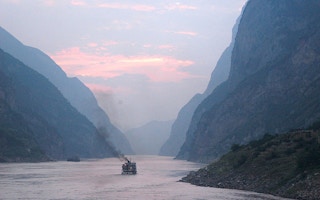The East Asian monsoon is pummeling China this summer. As of late July, flood alerts had been issued for 433 rivers, thousands of homes and businesses had been destroyed, and millions of people were on the verge of becoming homeless.
The water level of Poyang Lake, China’s largest freshwater lake, has risen to a record-breaking 22.6 metres (74 feet), prompting authorities in the eastern province of Jiangxi (population: 45 million) to issue “wartime” measures. Chinese citizens have not been threatened with devastation on this scale in more than 20 years, and this is likely just the beginning.
Destructive floods are not new to China, which has been reckoning with its powerful rivers for thousands of years. Historically, political stability has often depended on governments’ ability to tame them. The last time China was crippled by catastrophic floods, in 1998, more than 3,000 people died, 15 million were left homeless, and economic losses reached $24 billion.
“
The lessons of the twentieth century are clear. Rivers can be managed, but they are not amenable to control, and they are sure to grow more unwieldy as a result of climate change.
Reflecting the floods’ political importance, the Chinese government rushed to implement new measures – from infrastructure investment to land-use reforms – to prevent such a disaster from recurring.
China has since emerged as the world’s second-largest economy, owing to its pursuit of modernisation and advanced industrialisation. One of the principal factors in its success has been its extraordinary stock of river infrastructure.
Over the last 20 years, China’s river systems have been manipulated in unprecedented ways not only to avoid a repeat of 1998, but also to generate enough hydropower to sustain industrialisation. As a result, water flowing in the Yangtze River today encounters a globally unprecedented cascade of dams and infrastructure.
The crown jewel of this system is the Three Gorges Dam – the largest in the world – which is designed precisely to smooth the impact of a peak flood. In 2010, an unusually strong La Niña cycle in the eastern Pacific subjected the newly commissioned dam to its first big test.
In July of that year, its reservoir accommodated an onrush of 70,000 cubic metres of water per second. The reservoir’s water level rose by four meters, but it held, averting a disaster. The message was that China could now sleep soundly in the belief that the Yangtze had been tamed.
But water management is always provisional, because the risks are never eliminated. The reservoir behind the Three Gorges Dam is once again dangerously full, and the government has mobilised the military to reinforce levees that stand as the last line of defense for communities and businesses downstream.
Although the Yangtze’s flood-control systems are unlikely to fail completely, Chinese officials are rightly worried. Beyond the immediate physical effects, a significant failure would have severe, far-reaching political consequences.
An edifying historical parallel to China’s current situation is the Great Mississippi Flood of 1927, the worst in US history. Following months of heavy rains that began in the summer of 1926, the Mississippi River’s tributaries had reached capacity, and the levees broke.
Water inundated 27,000 square miles (70,000 square kilometres) of land, displacing 700,000 people. The flood struck a country that, like China today, had developed an unshakeable faith in its ability to control nature.
Beyond the immediate devastation, the Great Mississippi Flood had three long-lasting effects. First, it demonstrated that river control is an illusion; rivers can be managed, but never totally controlled.
Investments in expensive fixed assets like dams must be accompanied by a thoughtful approach to managing a live river system. Cement cannot be the only tool. Floodplains, insurance, and land-use policies also have an important role to play.
Second, successful flood management requires that all local stakeholders’ voices be heard. Almost a century after the Great Mississippi Flood, US officials still conduct boat trips and listening tours through communities on the lower Mississippi. In this exercise of real-time democracy, even the most powerful institutions are obligated by statute to hear, acknowledge, and consider local concerns.
Finally, the flood generated enormous political energy just when the global balance of power was shifting. The British Empire, the largest economy in the world, was in the throes of a fiscal crisis, whereas the United States had grown to become an economic powerhouse. America was increasingly becoming the world’s leading producer of grains, which meant that its farms and factories were at the root of its economic success.
The immediate response to the crisis was led by then-Secretary of Commerce Herbert Hoover, who enjoyed broad support (owing in no small measure to his own propaganda efforts). A year later, Hoover parlayed this support into clinching the Republican nomination for the presidency, which he went on to win.
But, in the meantime, fierce discontent among farmers in the lower Mississippi basin grew more intense following a drought in the Great Plains. This political ferment unleashed a wave of populism and protectionism that culminated in the infamous 1930 Smoot-Hawley Tariff Act, designed to shield US agricultural products.
The implementation of the tariff quickly spiraled into one of the most destructive trade wars of the twentieth century, deepening the Great Depression even further. The effects of the Mississippi flood were internationalised along the trade routes of the global economy.
It is far from clear how things will play out in China. As Chinese officials navigate the crisis, even a near-miss should prompt a reconsideration of their current approach to water-resources management. The lessons of the twentieth century are clear. Rivers can be managed, but they are not amenable to control, and they are sure to grow more unwieldy as a result of climate change.
The rest of the world should pay close attention to what is happening in the Yangtze River Basin. Riparian crises have a proven tendency to fuel social tensions and political instability. And the impact of a truly catastrophic flood in China would not affect that country alone.
Giulio Boccaletti is Chief Strategy Officer and Global Ambassador of Water at The Nature Conservancy.
Copyright: Project Syndicate, 2020.
www.project-syndicate.org









